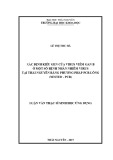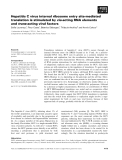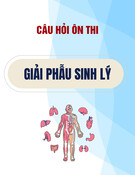
TỔNG QUAN Y KHOA
Số 8 (Tháng 11/2022) GẶP GỠ Y KHOA ǀ 18
THE ROLE OF NON-INVASIVE BIOMARKER M2BPGI IN MANAGING LIVER
DISEASE IN VIETNAMESE PATIENTS
Thuy Thi Thu Pham*, Dat Tan Ho, and Toan Nguyen
MEDIC Medical Center, Ho Chi Minh City, Vietnam
Phan Chu Trinh University, Da Nang, Vietnam
*Corresponding author: Thuy Thi Thu Pham, Email: drthuthuy@gmail.com
Abstract
Chronic liver disease has a high global burden and death toll. Early diagnosis is important to halt disease progression to
cirrhosis, hepatocellular carcinoma, and eventually death. At present, there are many methods used for liver disease
assessment, such as liver biopsy, elastography, serum biomarkers, and surrogate markers. However, shortcomings of
these methods include invasiveness, costly equipment, requirements for skilled technicians, long turnaround and waiting
times, which limit their usefulness, particularly in developing countries in the world that lack resources and skilled
technicians. Vietnam is a developing country with a high burden of hepatitis B and C, and liver disease-related mortality
is expected to increase in 2025. A recent study in Vietnam found that the Mac-2 binding protein glycosylation isomer
(M2BPGi) levels are correlated with elastography used for liver fibrosis staging. In this review, we examined the
challenges and prevalence of liver disease in Vietnam. We also reviewed the literature on the use of M2BPGi in liver
disease in other countries and discuss how this marker can be used to improve the detection and management of liver
disease as well as the challenges and problems faced.
Keywords: Hepatitis B, Hepatitis C, Mac-2 binding protein glycosylation isomer, chronic liver disease, Vietnam
Introduction
Liver disease causes 2 million deaths globally,
of which 1 million are due to cirrhosis and 1
million are due to viral hepatitis and
hepatocellular carcinoma[1]. There is also an
intricate link between viral hepatitis and liver
disease. Of note, the global burden of liver
cancer and cirrhosis has increased from 2012 to
2017[2]. Chronic inflammation occurs during
hepatitis B (HBV) and C (HCV) infections,
resulting in liver damage and subsequently liver
fibrosis to develop. This decreases hepatic
function and may eventually progress to
cirrhosis and hepatocellular carcinoma. Early
diagnosis and treatment can halt progression of
chronic hepatitis to liver fibrosis, cirrhosis and
hepatocellular carcinoma. With proper control,
this allows patients’ disease to be effectively
managed. At present, pan-genotypic
combinations off direct-acting antiviral drugs
have shown high efficacy in the treatment of
HCV caused by different genotypes[3] and
antiviral drugs are available to treat HBV[4].
These has demonstrated clear efficacy to drive
better disease treatment strategies. More tools
are needed to tackle initial liver disease
assessments and for long term management of
patients with hepatic fibrosis.
Liver disease assessment methods
Currently, there are many methods used for liver
fibrosis screening, of which liver biopsy is
considered the gold standard[5]. However, this is
an invasive procedure and it is not feasible to
carry out repeated biopsies, particularly in
advanced stage patients (>F3) in which
evaluation is required every 3-6 months. It is
also difficult to gain approval in early stage
patients as well, given these patients appear
generally healthy without significant symptoms.
Besides being invasive, liver biopsies are prone
to sampling errors and inter- and intra-observer
variability. These can cause errors in staging[6].
In rare but possible situations, liver biopsy can
also result in life-threatening complications[7]
and causes pain in 40% of patients[8].
Besides liver biopsy, elastography methods such
as transient elastography[9], magnetic resonance
elastography[10], and ultrasound-based
elastography[11] are used to assess liver fibrosis
stages. However, elastography has its
limitations, such as unreliability in obese
patients[12], patients with ascites[13], and requires
high operator skill. In magnetic resonance
elastography, patients need to hold their breath
and respiratory cooperation with the patient is
required. Also, this method is not suitable for
claustrophobic patients.
Serum biomarkers such as type III-procollagen-
N-peptide[14], lincRNA-p21[15], hyaluronic acid
(HA), platelet count, aspartate transaminase,
gamma-glutamyltransferase, are used alone or as
biomarker panels[16].








































